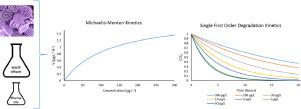Water Research ( IF 11.4 ) Pub Date : 2020-09-03 , DOI: 10.1016/j.watres.2020.116389 Sif B Svendsen 1 , Haitham El-Taliawy 2 , Pedro N Carvalho 1 , Kai Bester 1

|
Conventional wastewater treatment lacks the ability to remove many pharmaceuticals. This is leading to emissions to the natural aquatic environment, where these compounds pose a risk to the aquatic organisms. An advanced wastewater treatment technique that has shown promising results is Moving Bed Biofilm Reactors (MBBR). Initial degradation velocity and degradation rate constants of the pharmaceuticals are important parameters for designing an optimal MBBR system; however, the degradation efficiency varies across studies and one of the most plausible causes might be initial concentration. Thus, to verify the effect of initial concentration, the degradation of a mixture of 18 pharmaceuticals at different initial concentrations was studied. For this study MBBR's with very low BOD loading were used as they were conditioned with effluent water. The experiment was set up as a MBBR batch incubation, using effluent wastewater as medium, spiked with the 18 pharmaceuticals in seven different concentration levels (approximately 0–300 µg L−1). The degradation of 14 out of 18 pharmaceuticals was concentration-dependent. The initial degradation velocity of the pharmaceuticals was either proportional to the initial concentration or was following a typical Michaelis-Menten kinetic. The degradation velocity of one compound, i.e., sulfamethizole might have been inhibited at high concentrations. The degradation rate constants from single first-order fittings (KSFO) for some compounds deviated from the expected behavior at low concentrations (below 10 µg L−1). This is suggested to be caused by simplicity of the Michaelis-Menten model, not taking possible occurrence of co-metabolism and mass-transfer limitations into account at low concentrations. This study underlines the fact that K values cannot be interpreted without paying attention to the tested concentration level. Furthermore, it shows that the used MBBRs was able to handle high concentrations of pharmaceuticals, and that the most efficient removal occurs at concentrations above 100 µg L−1.
中文翻译:

生物膜反应器在污水处理厂废水中的浓度取决于药物的降解。
常规废水处理缺乏去除许多药物的能力。这导致向自然水生环境的排放,其中这些化合物对水生生物构成危险。移动床生物膜反应器(MBBR)是一种显示出可喜结果的先进废水处理技术。药物的初始降解速度和降解速率常数是设计最佳MBBR系统的重要参数。然而,降解效率因研究而异,最合理的原因之一可能是初始浓度。因此,为了验证初始浓度的影响,研究了18种药物混合物在不同初始浓度下的降解。在本研究中,使用BOD负荷非常低的MBBR进行了污水处理。L -1)。18种药物中有14种的降解是浓度依赖性的。药物的初始降解速度与初始浓度成正比,或者遵循典型的Michaelis-Menten动力学。在高浓度下,一种化合物,即磺胺甲唑的降解速度可能已被抑制。一些化合物的单个一阶拟合(K SFO)降解速率常数与低浓度(低于10 µg L -1时)的预期行为背离。)。认为这是由于Michaelis-Menten模型的简单性引起的,没有考虑到低浓度时可能发生的共代谢和传质限制。这项研究强调了一个事实,即如果不注意测试的浓度水平就无法解释K值。此外,它表明所用的MBBR能够处理高浓度的药物,并且最有效的去除发生在浓度高于100 µg L -1的情况下。











































 京公网安备 11010802027423号
京公网安备 11010802027423号